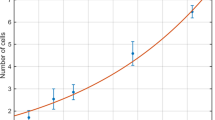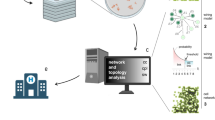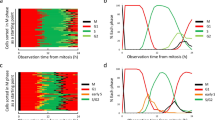Abstract
ONE of the most significant advances in cellular radiobiology was the development by Puck and Marcus1 of a technique by means of which the survival from irradiation of animal cells in culture was placed on a quantitative basis. Survival has usually been expressed arbitrarily as the ability of an irradiated cell to produce, over a 10–20-day period, a macroscopic clone of descendants comprising at least 50 ‘normal’ (that is, non-giant) cells.
This is a preview of subscription content, access via your institution
Access options
Subscribe to this journal
Receive 51 print issues and online access
$199.00 per year
only $3.90 per issue
Buy this article
- Purchase on SpringerLink
- Instant access to full article PDF
Prices may be subject to local taxes which are calculated during checkout
Similar content being viewed by others
References
Puck, T. T., and Marcus, P. I., J. Exp. Med., 103, 653 (1956).
Greenblatt, C. L., Intern. J. Rad. Biol., 4, 185 (1961).
Barendsen, G. W., in The Initial Effects of Ionizing Radiation on Cells, edit. by Harris, R. J. C., 183 (New York: Academic Press, 1961).
Taylor, J. H., J. Cell. Comp. Physiol., 62, Suppl. 1, 149, 150 (1963).
Tolmach, L. J., J. Cell. Comp. Physiol., 62, Suppl. 1, 150 (1963).
Archambeau, J. D., Drew, R. M., and Robertson, J. S., The Biological Effects of Neutron and Proton Irradiations, 1, 343 (Vienna: Intern. Atomic Energy Agency, 1964).
Whitmore, G. F., and Till, J. E., Ann. Rev. Nucl. Sci., 14, 347 (1964).
Elkind, M. M., and Sinclair, W. K., in Current Topics in Radiation Research, edit. by Ebert, M., and Howard, A., 1, 165 (Amsterdam: New Holland Publishing Co., 1965).
Author information
Authors and Affiliations
Rights and permissions
About this article
Cite this article
ROBINSON, D. ‘Cell Killing’ in Radiobiology. Nature 208, 500 (1965). https://doi.org/10.1038/208500a0
Issue date:
DOI: https://doi.org/10.1038/208500a0



